| |
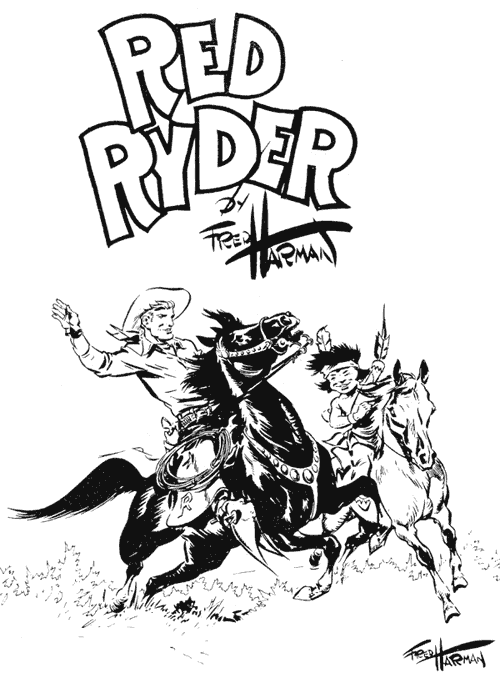
Fred Harman, Cowboy Cartoonist
Creator of Little Beaver and "You
betchum, Red Ryder"
Fred
Harman Jr. (middle name, Charles), famed cowboy cartoonist and painter
and the creator of Red Ryder and Little Beaver, grew up on a ranch and
remained intimately connected with ranching all his life. He was born
on February 9, 1902, in St. Joseph, Missouri, where his lawyer-rancher
father, Fred Charles Harman Sr., and mother, Birdie Olive Walker Harman
(who had once modeled for Charles Dana Gibson), were visiting relatives
while vacationing from their homestead near Pagosa Springs, Colorado.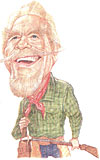
The
family returned to Colorado
when young Fred was two months old, and he grew to adolescence on the
ranch, learning how to ride horseback and herd cattle and teaching himself
to draw by copying pictures in mail-order catalogues. Recalling his
life and career in True West magazine (October 1968), Harman
wrote: "My recollections from two months to six years is on the
hazy side, but the fog sort of clears to find me bouncing back of Dad
in the saddle with both hands clawing his suspenders as he yelled, 'Hang
on, son!' He'd all but forget me while hazing an ornery milch cow hell
bent to a brush hideout to calve. Those words I was to remember all
through my life when the going got rough. Even now when a painting is
hard and discouraging, I recall, 'Hang on, son!' and start throwing
more paint." Harman's first published drawing appeared in a Saturday
youth section of the St. Joseph News-Press when he was six, but he didn't
begin to make a living with his graphic skill until he was eighteen.
In 1916, the Harmans, now including
two more sons, Hugh and Walker, moved to Kansas City, and young Fred, already skilled with horses, found
a before- and after-school job driving a grocery wagon. When the United States entered the European conflict in the spring of 1917,
he quit school to go to war. Too young to be inducted in his chosen
service, the Navy, he managed to join the Missouri National Guard. "After
many months guarding pipe and reservoirs to save Kansas City's precious water from the Germans, I was granted a
furlough and hightailed it back to Colorado," Harman wrote. He spent the summer and fall working
as a cowhand at ranches in the vicinity of the Harman homestead. By
Christmas 1918, he was back in Kansas
City,
a pressman's helper on the Kansas
City Star. There, he witnessed the operations of the paper's art
department and realized he could make a living drawing, but he never
lost his affection for the West and the outdoor life on a ranch. He
returned to Colorado again for the summer, but when he came back to
Kansas City the next year, he found a job animating cartoons for the
Kansas City Film Ad Company, where he worked with two other cartoonists
destined for future fame—Walt Disney and Ub Iwerks.
When these two started moonlighting
a film company of their own, Laugh-o-Grams, Harman joined them. After
the company went bankrupt and Disney left for Hollywood in the summer of 1923, Harman freelanced at commercial
art for a year and then went back to Colorado to savor cowboy life once again. That fall, he was
offered a position as the sixth artist in the art department of Artcrafts
Engraving Company in St. Joseph, eastern terminus of the legendary Pony
Express. He spent the next three years there, specializing in boots
and saddles; and he also designed the costumes for an MGM film about
the Pony Express. He met and, on June 26, 1926, married Lola May Andrews,
who was working in the music store on the ground floor of the building
that housed Artcrafts. When their son, Fred III, was born in 1927, Harman
began looking in earnest for a higher paying situation, and when Disney
invited him to join his growing operation in California, Harman took
a short vacation to reconnoiter the opportunity and to visit his brothers,
both of whom were then working in animation for Disney. Harman realized,
however, that animated cartooning was not for him, and he returned to
St. Joseph.
By December 1928, he was in St. Paul,
Minnesota, employed as an illustrator in the midwest's largest art department
at Buckbee-Mears. Soon thereafter, he and an advertising friend, Paul
McGinnis, established their own agency, Harman supplying the start-up
capital with freelance assignments from Buckbee-Mears. Their agency
did well until the Depression hit the Minnesota in 1932. By then, Harman
had decided upon a career producing art about the West; he sold his
partnership to McGinnis and prepared a series of short stories and illustrative
paintings entitled On the Range that he offered to the Des Moines Register-Tribune for syndication
to the Sunday rotogravure sections of newspapers. While awaiting a decision,
he and his family traveled in the spring of 1933 to the Colorado ranch,
where he built a cabin. Hearing nothing about his syndication proposal,
Harman went to Hollywood late that summer and arranged an exhibit of
his pen-and-ink cowboy drawings at a Wilshire Boulevard gallery. In
the fall, he brought his family west, and, financed by loans from his
brothers and their friends, he began syndicating himself a daily comic
strip about the Old West, Bronc Peeler.
Bronc is a gangly two-fisted fast-riding
redheaded young cowpoke, whose adventures Harman rendered in a confident,
sinewy penline that resonated authenticity, evoking the artist's own
early life on horseback in Colorado's Blanco Basin. The panels of the
strip brandish highspeed horseflesh and gnarly, bow-legged hombres as
Bronc chases after tinhorn gamblers, town bullies, horse thieves and
rustlers, stagecoach robbers, and owlhoots of every stripe. The genuine
appearance of the strip is so authoritative that its B-movie plots and
hoked-up lingo are very nearly overwhelmed by ambiance. In harness with
his Hollywood tradition, Bronc is accompanied on his early adventures
by a grizzled old desert rat named Coyote Pete, but when Harman's wife
suggested that a younger sidekick might attract a larger juvenile readership
for the strip, the cartoonist replaced Pete with a seeming Navajo kid
named Little Beaver, whose attire, Harman later admitted, was not at
all authentic and whose pidgin locutions were an affront to his ethnicity.
Having shot a trout with bow and arrow, Little Beaver chases it downstream,
saying "Me killum fish—now to ketchum before him float away."
Intended, perhaps, as comic relief, a plucky smart-mouthed sidekick,
Little Beaver was much more: ingenious and courageous, he was often
in the right place at the right time to rescue his mentor, and the boy
proved quickly more popular than the old timer he'd displaced. When
Harman added a Sunday strip to his workload on October 7, 1934, he also
produced a linear newsprint-suitable version of his earlier On
the Range paintings for the bottom half of the page, accompanying
it with an artificial rustic Will Jamesian patois describing life in
the Old West.
The work of self-syndication was daunting:
Harman wrote his continuities, drew the strip, arranged for the engravings
to be made and mats to be shipped to client newspapers, and drove around
the country, trying to sell the feature to newspaper editors. He also
sold Bosko, a strip about
a clown character based upon the animated cartoon created by his brother
Hugh and his partner Rudolph Ising. In 1936, the syndication of Bronc Peeler was taken over by Consolidated News Features until the
strip ceased in 1938. During the strip's five-year run, Harman remained
on the West Coast and met many notables in and around the movie lots—Gene
Autry, who later financed a movie about Harman's later creation, Red
Ryder; Will James, the cowboy artist-writer; Emmett Dalton, the last
of that outlaw family; Al Jennings, the old train robber; and Curley
Fletcher, the "Cowboy Poet" and author of "The Strawberry
Roan." Fletcher had an idea for a slick magazine about the West
and persuaded Harman to join him in the enterprise, Ride,
which they wrote and drew for three issues before it collapsed for want
of capital.
Harman's break came in 1938 shortly
after he had illustrated a Big Little Book, Cowboy
Lingo, for Whitman Publishing Company. Sam Lowe, Whitman's president,
liked Harman's work and recommended an agent in New York, Stephen Slesinger.
Slesinger had an assignment for Harman, illustrating a book about cowboys
and Indians, and Harman promptly moved to New York and joined Slesinger's
art staff, leaving Bronc Peeler
in the dust. While on staff, Harman may have tried out to draw King of the Royal Mounted, a comic strip produced by Slesinger. But
he soon found his metier elsewhere. That summer, as Harman tells it,
"Fred Ferguson, president of Scripps Howard's NEA newspaper syndicate,
came into the office inquiring about a Fred Harman he had heard about
who drew a Little Beaver cartoon. When I stuck out my eager paw and
said, 'Howdy—I'm Fred Harman,' he dang near lost his voice in surprise."
At Ferguson's instigation, Harman created a sample Sunday comic strip
in which Bronc Peeler was transformed into Red Ryder, and Slesinger
negotiated a ten-year contract with NEA. Red
Ryder debuted November 6, 1938, its raw-boned redheaded hero in
his signature red shirt, white wide-brimmed low-crown hat, and chaps;
a daily strip started March 27, 1939.
Red Ryder is older and broader of shoulder
than his antecedent, but Little Beaver is exactly the same: spunky and
out-spoken, he is the human chorus to Red's granite-faced struggle against
rascality, grunting a supportive "You betchum, Red Ryder"
with such regularity that the expression became a catch phrase. The
stories have the same sort of fast-breaking action-packed plots and
central-casting villains as before. Harman was now drawing with a juicy
brush, splashing drawings through the panels in a fluid, sketchy manner,
accenting them with realistic black shadow. Fittingly in a Western,
Red is on horseback much of the time, astride a big black horse named
Thunder (Little Beaver rides a paint pony called Papoose), and Harman
could make his hero sit a horse convincingly. The bandy-legged 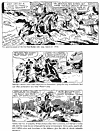 mannerisms
of Bronc Peeler are continued,
as is Harman's characteristic treatment of everything wooden, imparting
a knotty reality to the environs—fence posts tilt askew in the parched
earth, the planks of board walks and buildings are weathered and warped
in the sun and are therefore uneven, the wheels on wagons almost certainly
wobble; every landscape has towering buttes in the distance, and shaggy
pine trees and tufts of scraggly juniper bushes are everywhere along
the hillside trails near the little Colorado town of Rimrock. mannerisms
of Bronc Peeler are continued,
as is Harman's characteristic treatment of everything wooden, imparting
a knotty reality to the environs—fence posts tilt askew in the parched
earth, the planks of board walks and buildings are weathered and warped
in the sun and are therefore uneven, the wheels on wagons almost certainly
wobble; every landscape has towering buttes in the distance, and shaggy
pine trees and tufts of scraggly juniper bushes are everywhere along
the hillside trails near the little Colorado town of Rimrock.
In the first year or so of the strip's
run, Red meets his life-long paramour, the dark-haired beauty Beth Wilder,
and his arch enemy, Ace Hanlon, the card sharp scoundrel who would periodically
for the next twenty-five years pester the townspeople with one swindle
after another. Completing the cast of regulars are Rimrock's cantankerous
Sheriff Newt and Red's aunt, the Duchess, a doughty matriarchal old
scout whose rough edges never quite conceal the warmth of her heart;
she manages Red's ranch whenever her tumbleweed nephew is off righting
wrongs or supplementing his income as a hired gun. But Little Beaver
was undoubtedly the most popular of the strip's cast (so much so that
much subsequent publicity referred to the strip as "Red Ryder and
Little Beaver," suggesting Harman's attachment to the character
that rescued him from a life illustrating children's books for Slesinger).
The affectionate and respectful relationship between the resourceful
wise-cracking kid and the big sober-sided redhead was arguably what
gave the otherwise headlong action strip its heart and endeared it to
its readers. During World War II, the Indian youth's name was also deployed
with several combat units that effectively adopted him as a mascot.
Red
Ryder was the most successful western in comic strip history, appearing,
eventually, in 750 newspapers. Republic Pictures produced a 12-chapter
serial in 1940, followed by 27 feature-length motion pictures (1944-49);
and a radio program started in February 1942 and ran three half-hour
programs a week until 1951, part of the time standing higher in the
Hooper ratings than "The Lone Ranger" on a rival network.
The Red Ryder comic book appeared
sporadically beginning in September 1940, became bi-monthly in December
1943 and monthly in January 1946 until the last issue, no. 151, in April
1957. Red Ryder's name was used on an array of merchandise, the most
celebrated of which was the Daisy 111 Model 40 Red Ryder Western Carbine,
known popularly as the Red Ryder BB gun, which was first offered to
the purchasing public in 1939 for $2.95. Ubiquitously advertised on
the back covers of comic books through the 1950s, the rifle continued
to be a popular item for the rest of the century.
His financial success assured by 1940,
Harman returned to his roots, buying land near Pagosa Springs and building
on the slope of Square Top Mountain a cabin with an majestic view of
the rugged San Juan Mountains of Archuleta County. Although he envisioned
his domicile as a hideaway, the promotional press dubbed it "Red
Ryder Ranch," and it was soon the destination of touring fans of
the strip. 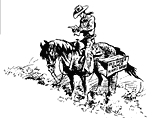 The
red-haired Harman participated enthusiastically in publicity campaigns,
appearing around the country at rodeos as "Red Ryder," and
he always had a "Little Beaver" imitator with him, a succession
of youths recruited from the nearby Jicarilla Reservation. The cartoonist
was active in operating the ranch, too, and once, for a time, drew with
his arm in a slin The
red-haired Harman participated enthusiastically in publicity campaigns,
appearing around the country at rodeos as "Red Ryder," and
he always had a "Little Beaver" imitator with him, a succession
of youths recruited from the nearby Jicarilla Reservation. The cartoonist
was active in operating the ranch, too, and once, for a time, drew with
his arm in a slin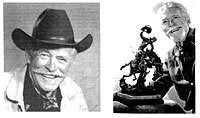 g,
the casualty of a bronc-busting afternoon. Harman continued to control
the activities of his creations, but he acquired assistant artists over
the years so that he would have time to paint, and when the strip ceased
December 26, 1964, it was being produced almost entirely by Bob MacLeod.
Harman, meanwhile, resumed full-time a painting career that had been
interrupted for thirty years. g,
the casualty of a bronc-busting afternoon. Harman continued to control
the activities of his creations, but he acquired assistant artists over
the years so that he would have time to paint, and when the strip ceased
December 26, 1964, it was being produced almost entirely by Bob MacLeod.
Harman, meanwhile, resumed full-time a painting career that had been
interrupted for thirty years.
Harman began wintering in Albuquerque
and finally bought a year around home and studio in Phoenix. Before
he died on January 2, 1982, of complications from a stroke suffered
December 27, 1981, Harman produced over 350 oil paintings, scores of
pen-and-ink drawings, and numerous bronze sculptures on Western themes.
 He
had been inducted into the Society of Illustrators early in his comic
strip career and was a charter member of the National Cartoonists Society.
In 1958, he received the Sertuma Club's American Way of Life Award for
Colorado's Outstanding Citizen, and other awards included those from
the U.S. Treasury, the Department of Defense, the U.S. Navy, and the
State of Texas. In 1963, he joined four other artists (Joe Beeler, Charlie
Dye, Jon Hampton and George Phippen) to found the Cowboy Artists of
America. Among the honors Harman valued most was his official adoption
into the Navajo nation, a distinction enjoyed by only 75 other non-Native
Americans. His name and comic strip creation are perpetuated in the
annual Pagosa Springs Red Ryder Rodeo, a suitable legacy of cartooning's
most accomplished representation of the American West. He
had been inducted into the Society of Illustrators early in his comic
strip career and was a charter member of the National Cartoonists Society.
In 1958, he received the Sertuma Club's American Way of Life Award for
Colorado's Outstanding Citizen, and other awards included those from
the U.S. Treasury, the Department of Defense, the U.S. Navy, and the
State of Texas. In 1963, he joined four other artists (Joe Beeler, Charlie
Dye, Jon Hampton and George Phippen) to found the Cowboy Artists of
America. Among the honors Harman valued most was his official adoption
into the Navajo nation, a distinction enjoyed by only 75 other non-Native
Americans. His name and comic strip creation are perpetuated in the
annual Pagosa Springs Red Ryder Rodeo, a suitable legacy of cartooning's
most accomplished representation of the American West.
Bibliography. The most detailed account of Harman's
life until the syndication of Red
Ryder is the autobiographical article, "New Tracks in Old Trails"
in True West, September-October 1968. Other
accounts include "He's At Home on the Range and Quick on the Draw"
by Paul Friggens, Quill, February
1939; "Ryder of the Comic Page" by James Poling, Collier's, August 1948; and "Red Ryder's Eternal Home on the
Range" by Mark Yost, Wall
Street Journal, December 23, 2003 (all somewhat inflated with promotional
mythology) and entries in Comics
of the American West (1977) by Maurice Horn and The Encyclopedia of American Comics (1990) edited by Ron Goulart as
well as Goulart's The Adventurous
Decade (1975). Dean Krakel's introduction to a book of Harman's
paintings, The Great West in Paintings (1969), also
supplies a few details. Red Ryder's celluloid career began with a twelve-chapter
Republic serial, The Adventures
of Red Ryder, starring Don "Red" Barry (1940), which was
followed by 27 feature-length films: all Republic films with "Wild"
Bill Elliott, George "Gabby" Hayes (first two), and Bobby
Blake as Little Beaver– Tucson Raiders (1944, May 14); Marshall of Reno (1944, July 2); The San Antonio Kid (1944, August 16);
Cheyenne Wildcat (1944, September 30);
Vigilantes of Dodge City (1944, November
15); Sheriff of Las Vegas (1944,
December 31); Great Stagecoach
Robbery (1945, February 15); Lone
Texas Ranger (1945, May 20); Phantom
of the Plains (1945, September 7); Marshall
of Laredo (1945, October 7); Colorado
Pioneers (1945, November 14); Wagon
Wheels Westward (1945, December 21); California
Gold Rush (1946, February 4); Sun
Valley Cyclone (1946, May 10); Conquest
of Cheyenne (1946, June 29); Sheriff
of Redwood Valley (1946, September 29); with Allan "Rocky"
Lane as Red Ryder– Santa Fe Uprising (1946, November 15); Stagecoach to Denver (1946, December 23);
Vigilantes of Boomtown (1947,
February 15); Homesteaders of
Paradise Valley (1947, April 1); Oregon
Trail Scouts (1947, May 5); Rustlers
of Devil's Canyon (1947, July 1); Marshall
of Cripple Creek (1947, August 15); then in Equity/Eagle Lion films
with Jim Bannon as Red Ryder and Don Kay Reynolds as Little Beaver– Ride,
Ryder, Ride (1949, February 1); Roll,
Thunder, Roll (1949, August 27);
The Fighting Redhead (1949, October 12); Cowboy
and the Prizefighter (1949, December 15).
Harman's papers and many of his oil paintings and other art works
are archived or on display at the Fred Harman Western Art Museum, once
the cartoonist's home near Pagosa Springs, Colorado. The New York Times published a brief obituary, January 5, 1982.
Return to Harv's Hindsights
|